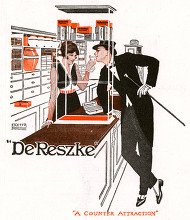"How can we connect the way that vapes are treated now, and were treated a few years ago when even less was known about their negative effects, to how cigarettes were glamorized in the 1950s, and why is it important to remember the fraught past of cigarette advertising?" -- Margaret Gray, 11th Grade
It’s no secret that cigarette companies blatantly lied to their consumers for decades until they were not legally allowed to anymore. It’s also clear that although the quest to de-glamorize cigarettes has been almost completely successful, the nation still has a problem with nicotine addiction. How can we connect the way that vapes are treated now, and were treated a few years ago when even less was known about their negative effects, to how cigarettes were glamorized in the 1950s, and why is it important to remember the fraught past of cigarette advertising?
Knowing what we do now about cigarettes and the effects they have on the human body, cigarette ads from the 1940s and 50s seem almost satirical. Surely people didn’t actually believe that smoking would help the throat and be beneficial to health, right? The list of problems that come with long term, regular smoking are well known to most people who’ve been through a drug education class like sex ed. Lung and throat cancer, yellowed teeth, shortness of breath, and an increased chance of brain stroke and brian damage are just some of the problems. However, in the 1940s, it was suggested that the cure to some physical ailments--a sore throat, for example--could actually be helped by smoking cigarettes. This was not an accident, and doctors and scientists in the 1950s knew that cigarettes were bad for people. However, they didn’t speak up. This is because cigarette companies manipulated the spread of information. Cigarette companies had a few different tactics to convince people that smoking was healthy. For one thing, they paid doctors to say that cigarettes were healthy for ads. They also paid other doctors not to speak out about the negative health effects. Sometimes companies created biased surveys that made it seem like doctors favored a certain brand. They bribed other specialty doctors to pick certain brands. It wasn’t until 1964 that a report about the dangers of smoking came out.
That wasn’t the end of the manipulation, either. Tobacco companies like R.J. Reynolds tobacco company, which owns Camel cigarettes, paid for celebrity endorsements, putting cigarettes into mainstream media and associating them with glamour and class. They also just lied in their ads about health effects, and when the government asked them to stop, they simply didn’t listen. This tactic, which is a little sneakier than lying or bribing doctors, is something we still see today. It’s harder for the government to regulate what sneaks into the media we watch, and so even now, when programs like “Truth” have spread a great deal of knowledge about the negative parts of smoking, movies and TV still tend to glamourize smoking cigarettes. They’re smoked by the cool kids, or by someone’s favorite character, and this portrayal directly influences the choices teens make about whether or not they should try cigarettes.
Vapes weren’t marketed as beneficial, but when they first came out, they were seen as a safe alternative to smoking cigarettes, which made them perfect for people trying to quit. They were advertised in a similar way, but not to the same degree; instead of promising good health like vintage cigarette ads did, vape ads promised an easy way to quit smoking, which is a massive problem in many people’s lives. However, again, tobacco companies began to target children with flavored vapes and since there just wasn’t information on how safe they were the cycle seems to have started again. A whole new generation has been exposed to harmful advertisements from tobacco companies, and a whole new generation is addicted to nicotine as a result. As the government realizes the negative health effects of vaping, they have cut back on what’s legal, and as a result, many kids are addicted but have no way to get the nicotine they were smoking before; and so, in a very ironic twist of fate, they oftentimes end up smoking cigarettes, as they’re more accessible. Vapes have restarted the problem that was finally being solved by the spread of factual information. How long will this be a problem in America? When we finally realize vapes are dangerous, too, what new device while the tobacco industry create to get kids addicted to nicotine like they have for the past century?
Knowing what we do now about cigarettes and the effects they have on the human body, cigarette ads from the 1940s and 50s seem almost satirical. Surely people didn’t actually believe that smoking would help the throat and be beneficial to health, right? The list of problems that come with long term, regular smoking are well known to most people who’ve been through a drug education class like sex ed. Lung and throat cancer, yellowed teeth, shortness of breath, and an increased chance of brain stroke and brian damage are just some of the problems. However, in the 1940s, it was suggested that the cure to some physical ailments--a sore throat, for example--could actually be helped by smoking cigarettes. This was not an accident, and doctors and scientists in the 1950s knew that cigarettes were bad for people. However, they didn’t speak up. This is because cigarette companies manipulated the spread of information. Cigarette companies had a few different tactics to convince people that smoking was healthy. For one thing, they paid doctors to say that cigarettes were healthy for ads. They also paid other doctors not to speak out about the negative health effects. Sometimes companies created biased surveys that made it seem like doctors favored a certain brand. They bribed other specialty doctors to pick certain brands. It wasn’t until 1964 that a report about the dangers of smoking came out.
That wasn’t the end of the manipulation, either. Tobacco companies like R.J. Reynolds tobacco company, which owns Camel cigarettes, paid for celebrity endorsements, putting cigarettes into mainstream media and associating them with glamour and class. They also just lied in their ads about health effects, and when the government asked them to stop, they simply didn’t listen. This tactic, which is a little sneakier than lying or bribing doctors, is something we still see today. It’s harder for the government to regulate what sneaks into the media we watch, and so even now, when programs like “Truth” have spread a great deal of knowledge about the negative parts of smoking, movies and TV still tend to glamourize smoking cigarettes. They’re smoked by the cool kids, or by someone’s favorite character, and this portrayal directly influences the choices teens make about whether or not they should try cigarettes.
Vapes weren’t marketed as beneficial, but when they first came out, they were seen as a safe alternative to smoking cigarettes, which made them perfect for people trying to quit. They were advertised in a similar way, but not to the same degree; instead of promising good health like vintage cigarette ads did, vape ads promised an easy way to quit smoking, which is a massive problem in many people’s lives. However, again, tobacco companies began to target children with flavored vapes and since there just wasn’t information on how safe they were the cycle seems to have started again. A whole new generation has been exposed to harmful advertisements from tobacco companies, and a whole new generation is addicted to nicotine as a result. As the government realizes the negative health effects of vaping, they have cut back on what’s legal, and as a result, many kids are addicted but have no way to get the nicotine they were smoking before; and so, in a very ironic twist of fate, they oftentimes end up smoking cigarettes, as they’re more accessible. Vapes have restarted the problem that was finally being solved by the spread of factual information. How long will this be a problem in America? When we finally realize vapes are dangerous, too, what new device while the tobacco industry create to get kids addicted to nicotine like they have for the past century?


